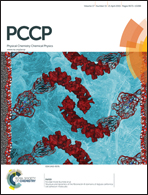Singlet–triplet gaps in polyacenes: a delicate balance between dynamic and static correlations investigated by spin–flip methods†
Abstract
Over the last few years people have been interested in the process of singlet fission, owing to its relevance to solar cell technology. The energetics of singlet fission is intimately related to singlet–triplet (ST) gaps and energies of singlet excited states. However, accurate calculations of ST gaps in polyacenes are complicated due to near degeneracies in the π orbitals, and therefore, have been quite challenging. The spin–flip equation-of-motion coupled-cluster (SF-EOM-CC) and its perturbative approximation have been shown to correctly treat situations involving electronic degeneracies and near degeneracies. In this work, we use various spin–flip methods to benchmark the ST gaps of small polyacenes and show that the error in the ST gaps with respect to the experiment is small and does not increase appreciably with the system size. The diradical and polyradical character of the polyacene ground states increase with the system size. However, for the small polyacenes the open-shell character of the ground state is still small enough to be treated using single reference methods.

- This article is part of the themed collection: PCCP Emerging Investigator Lectureship Award Winners

 Please wait while we load your content...
Please wait while we load your content...